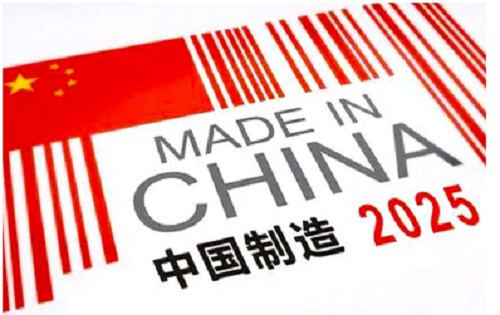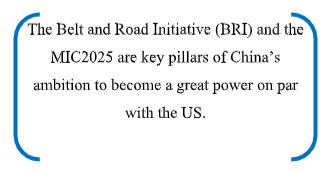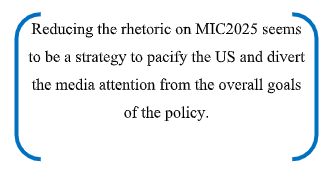Megha Pardhi, Research Intern, ICS

The Made in China 2025 (MIC) policy was launched in May 2015 as an umbrella policy to develop ten high technology focussed sectors and convert China into a technological powerhouse. This came after increasing worries that China would lose its competitive edge over developed economies due to rising labour costs. A state led plan for ten years was released by Chinese Premier Li Keqiang to develop 10 key sectors: New information technology, Numerical control tools, Aerospace equipment, High tech ships, Railway equipment, Energy saving, New materials, Medical devices, Agricultural machinery, and Power equipment. It contained key performance indicators like R&D costs, patents, Manufacturing Competitiveness, Broadband penetration etc. to measure the performance of various sectors from 2015 to 2025.
The ‘Internet Plus’ policy launched in 2015 by Chinese Premier Li Keqiang compliments the goals of MIC2025. The ‘Internet Plus’ policy aims to integrate the internet with traditional industries and manufacturing sector. Some scholars in China have also touted the ‘Internet Plus’ policy as a key to handling overcapacity in Chinese manufacturing sector.

MIC2025 is believed to be inspired from Germany’s Industry 4.0 initiative. ‘Self-sufficiency’ is among the primary motivators behind this policy. Regulatory changes, state led financing, developing industry standards, industry-academia collaboration, international brand awareness, etc. are its other salient features.
The MIC2025 policy garnered significant international attention within geopolitical and economic circles mainly on account of it being representative of China’s ambitions. A host of concerns were voiced including discriminatory treatment of foreign bustiness, unfair trade practices, forced technology transfers, intellectual property theft, and security. For example, the 2017 IP Commission report estimates the cost of Chinese IP theft to be around $225 million to $600 million. The US also started investigations into technology transfer allegations and considered banning some Chinese companies over allegations of IP theft.
These fears are not new. Author Mara Hvistendahl in her book, ‘The Scientist and the Spy: Chinese industrial espionage and the atmosphere of fear in the West’ tells an intriguing story of industrial espionage by ethnic Chinese scientists in the US. Moreover, MIC2025 was not the first of China’s policies viewed with suspicion. More than a decade ago, China’s “The National Medium- and Long-Term Plan for the Development of Science and Technology (2006-2020)” was also criticised as “a blueprint for technology theft on a scale the world has never seen before.” The ambitious nature of the MIC2025 complimented with growing assertiveness in Chinese foreign policy under Xi Jinping added to the heightened insecurities of the Western countries.

The anxiety in the West, especially in the United States over this policy stems from multiple reasons. First, currently the US is a world leader in the high technology industry and innovation. The MIC2025 not only aims to move China up in high technology manufacturing ladder, but also aims to make China a world leader in research and innovation. Second, China’s rise to great power status does not bode well with the interests of the US. In 2018, National Security Strategy of the US termed China as a ‘revisionist state’. The Belt and Road Initiative (BRI) and the MIC2025 are key pillars of China’s ambition to become a great power on par with the US. Third, the strategic technology development aspect of this policy means China would be self-sufficient in the advanced strategic technologies. This in turn would strengthen China’s position in Asia and world as a security provider over which the US has had a practical monopoly since the end of the Cold War. Hence even though the MIC2025 aims primarily to develop high tech manufacturing, its geopolitical implications cannot be ignored.
In recent years, there have been reports of the Chinese government toning down the rhetoric on MIC2025. As a result, the MIC2025 does not appear much in official documents and media anymore. However, this does not mean that China has abandoned the project completely.
It can even be argued that the US-China trade war which began in 2018 was a manifestation of discontent frothing beneath the surface. The targeting of Huawei, which is also identified as a key company under the MIC2025, was perhaps not a coincidence. Perhaps due to these setbacks the Chinese premier Li Keqiang omitted to mention ‘Made in China 2015’ in his address to the opening session of National People’s Congress in 2019.

Does this mean MIC2025 is dead? Even if direct references to the MIC2025 have reduced, the spirit of the policy is still alive. Various aspects of the MIC205 policy are still active and the targets are being pursued.
First, a media analysis of Beijing’s response to the US pressure during trade war by Eliot Chen noted that “the fact that MIC2025 is being directly linked to Reform and Opening Up suggests that Beijing continues to attach significance to the plan, if not in name then in substance and spirit.” The author goes on to explain that even though the references to MIC2025 in media have almost vanished, the idea and inspirations behind the policy has not. To analyse this, he uses the two terms relating to MIC2025 ‘Indigenous innovation’ and ‘Core technology’. His analysis shows that there has been a significant spike in the in the use of term ‘core technology’ in second quarter of 2019.
Second, the 2019 speech of Li includes many aspects of the key industries envisioned for development under MIC2025 without mentioning the policy directly. The references to the “high quality manufacturing” and “boosting technological innovation capacity” point indirectly towards the goals envisioned MIC2025.
Third, the Ministry of Industry and Information Technology (MIIT) which is responsible for the overall implementation and coordination of the MIC2025 is still working towards the goals of the policy For example, the documents released by MIIT since 2019 till now include range of initiatives like “formulation and revision of 10 national standards” in communications industry, “Strengthening the Construction of Quality Brands to Support the High-quality Development of Manufacturing Industry”, “Declaring the Cities (Prefectures) with Stable Industrial Growth and Transformation and Upgrading in 2019”. Moreover, the newly appointed head of MIIT, Xian Yaquing is a technocrat who is expected to have control over licensing of new technologies like electric cars and 5G. Also, in the aftermath of COVID19, China aims to increase the domestic consumption to revive the economy. For example, in June 2020 Li Keqiang presented a work report to National People’s Congress (NPC) which refers to the push towards consumption including e-commerce facilities in rural areas. Tapping these previously untouched regions can provide a boost to the China’s manufacturers. These examples indicate the slow and steady move towards the larger goals of developing a high-tech manufacturing industry in near future, if not as envisioned under rhetoric and timeline of MIC2025
In conclusion, reducing the rhetoric on MIC2025 seems to be a strategy to pacify the US and divert the media attention from the overall goals of the policy. The post COVID19 world seems more determined to face the China challenge, whether it is the US or developing countries such as India. It remains to be seen whether China’s ambition to gain leadership in technology will survive these challenges.